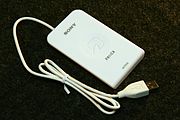FeliCa
From Wikipedia, the free encyclopedia
FeliCa is a contactless RFID smart card system by Sony, primarily used in electronic money cards. The name stands for Felicity Card. First utilized in the Octopus card system in Hong Kong[1], the technology is used in a variety of cards also in countries such as Singapore and Japan.
Contents |
[edit] Technology

FeliCa's encryption key is dynamically generated each time mutual authentication is performed, preventing fraud such as impersonation.
FeliCa is externally powered, i.e. it does not need a battery to operate. The card uses power supplied from the special FeliCa card reader when the card comes in range. When the data transfer is complete, the reader will stop the supply of power.
FeliCa was proposed for ISO/IEC 14443 Type C but was rejected. However, it has since been standardized as ISO/IEC 18092 (Near Field Communication). It uses Manchester coding at 212 kbit/s in the 13.56 MHz range. A proximity of 10 centimeters or less is required for communication.
The UK IT security evaluation and certification scheme provides more detail as to the internal architecture of the FeliCa card (RC-S860 ). FeliCa IC card (hardware) and its operating system has obtained ISO15408 Evaluation Assurance Level 4 (“EAL4”), a standard which indicates the security level of information technology and consumer products.
[edit] Reliability
FeliCa supports simultaneous access of up to 8 blocks (1 block is 16 bytes). If an IC card is moved outside of the power-supplied area during the session, the FeliCa card automatically discards incomplete data to restore the previous state.
[edit] Mobile FeliCa
Mobile FeliCa is a modification of FeliCa for use in mobile phones by FeliCa Networks[1], a subsidiary company of both DoCoMo and Sony. NTT DoCoMo has developed a wallet phone concept based on Mobile FeliCa and has developed a wide network of partnerships and business models. au and SoftBank (former Vodafone Japan) have also licensed mobile FeliCa from FeliCa Networks.
The Osaifu-Keitai (おサイフケータイ ) system (literal translation: "wallet-phone") was developed by NTT DoCoMo, and introduced in July of 2004 and later licensed to Vodafone and au, which introduced the product in their own mobile phone ranges under the same name. Using Osaifu-Keitai, multiple FeliCa systems (such as Suica and Edy) can be accessed from a single mobile phone. On January 28, 2006, au introduced Mobile Suica which is used primarily on the railway networks owned by JR East.
[edit] Consumer reader/writer devices
Sony have built in a FeliCa reader/writer known as "FeliCa Port" into their VAIO PC line. Using the device, FeliCa cards can be used over the Internet for shopping and charging FeliCa cards.
An external USB FeliCa PC reader/writer has been released as well, called PaSoRi. It is USB powered and allows one to perform online transactions and top up EZ-link cards in Singapore with credit cards or debit cards anywhere, as long as there is direct access to the Internet.
[edit] Card usage
- Octopus cards, Hong Kong
- Shenzhen TransCard, Shenzhen, China
- Pay Ease, Chong Qing, China
- Unified Automatic Fare Collection Scheme completed by Q4 2009,Dubai, United Arab Emirates
- Travel card, India
- EZ-link, Singapore
- Metro Card (Bangkok)|Metro Card, Bangkok, Thailand
- GoPhila card, Philadelphia, USA
- SPASS card, Dhaka, BRTC, Bangladesh [[2]]
- Japan: The system is de facto standard in Japan.
- Electronic money or mobile payment:
- Edy, bitWallet
- eLIO, Sony Finance International
- iD, NTT DoCoMo
- nanaco, Seven & I Holdings Co.
- Osaifu Keitai
- QUICPay, Japan Credit Bureau and AEON Credit Service
- Smartplus, Mitsubishi UFJ NICOS
- ToruCa, NTT DoCoMo
- Visa Touch, Visa International
- WAON, AEON Group
- Public transportation payment: (Some can be used as electronic money as well.)
- Major cards:
- ICOCA, JR West
- Kitaca, JR Hokkaidō
- PASMO, railways and buses in Kantō region (includes Tokyo)
- PiTaPa, railways and buses in Kansai
- SUGOCA, JR Kyūshū
- nimoca, Nishitetsu, public transportation in Fukuoka Prefecture
- Suica, JR East
- TOICA, JR Central
- See the table below for other cards.
- Major cards:
- Electronic money or mobile payment:
[edit] Integrated services in Japan
As FeliCa is the de facto smart card ticketing system standard in Japan, many of these cards have integrated services. A particular region/operator may accept multiple cards.
The table below shows the integrated services FeliCa cards have for each Japanese region.
- A: The area accepts all functions of the card, including electronic money function. (There may be subtle differences between each area.)
- B: The area accepts basic functions of the card, but not some functions such as electronic money or auto recharging.
- A: The area will introduce the new card in future.
- F: The area will accept the card in future.
- A few cards can be used as electronic money in some unmarked areas.
- 1: In many cases, there are multiple operators accepting the same card in the same area. See each card article for the full listing.


